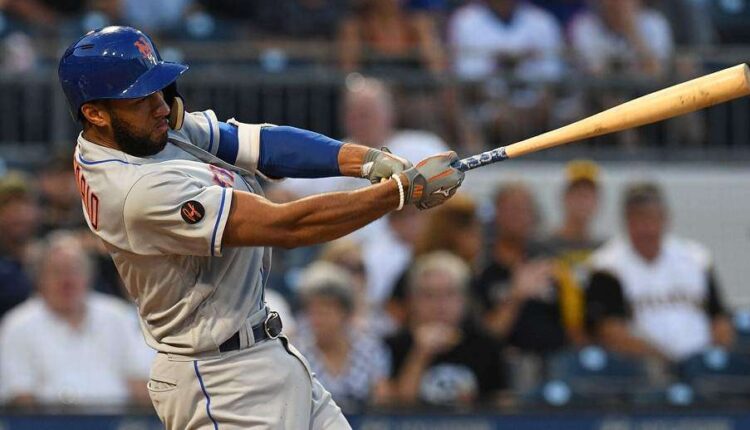The season’s almost over. For some owners, the playoffs are underway or there’s room for jockeying in roto categories over the next two weeks. Not everyone can be so fortunate though. Many owners have to turned their attention to 2019, considering keepers in dynasty leagues or get a much-too-early head start in preparing for redraft leagues. I’ll try to thread the needle today, looking at Amed Rosario, who has been performing well recently and isn’t universally owned. Not only can he offer some value down the stretch, but a significant bat-to-ball improvement promises an interesting profile for 2019 and beyond.
Amed Rosario
Amed Rosario’s season line may be a bit disappointing: .259/.299/.395 with nine home runs and 18 stolen bases. Even at shortstop, that’s not must-own production. Contextualize this season a bit, though, and Rosario looks like a great dynasty asset. He was, of course, a top prospect just over a year ago and having played this season at age 22, he’s younger than Nick Senzel. It’s fair to discount Rosario’s outlook a little bit for his subpar 700 MLB plate appearances, but keep in mind that he’s still one of baseball’s 50 youngest players.
Rosario’s got more than age-related projection, though. He’s already shown rather significant offensive development in his MLB career. Take, for instance, Rosario’s 25-game rolling average strikeout rate, courtesy of Fangraphs.

There are peaks and valleys, as there would be with any hitter, but the trend is unmistakable. After a strikeout-filled debut season that mostly carried over into April, Rosario’s struck out less often than average in four of the past five months. My Fantrax colleague Jeff Zimmerman found a few years ago that young hitters tend to improve on their strikeout rates until about age-26, so there’s reason to believe that Rosario can sustain, if not build off this improvement.
Maybe you’re not buying, though, that just because the average hitter cuts his strikeout rate until his mid-20’s that Rosario can too. Each player is different, after all. Let’s look at how Rosario has gone about lopping off these easy outs. Unsurprisingly it starts with swinging and missing less often.

Nothing crazy here. We can get more granular, though. Rosario’s having more success on pitches within the strike zone.

Rosario’s improvement against fastballs is stark, immediate and seemingly sustainable. Through June, Amed Rosario swung through around a quarter of in-zone heaters he saw, an untenable rate considering that in-zone fastballs are the pitches on which hitters tend to do the most damage. Beginning in July, Rosario halved his swinging strike rate on those pitches, and he’s essentially held those gains ever since, as can be seen in this graph from Baseball Savant.

Maybe this reflects a process change. Compare the fastballs that Rosario swung at over the first year-plus of his MLB career with the ones that he’s attacked over the past few months.


It does appear as though Rosario’s targeting pitches a bit further away from his body than he used to. For a long-armed player like Rosario, the outside pitch could theoretically be easier to handle than the ball on the inner half, since he can afford to let the ball travel deeper into the hitting zone. Alternatively, this might reflect some mechanical alteration. Mechanics are always difficult to gauge from a center field view, and I couldn’t find any report that Rosario’s doing anything differently with his swing, so take this with a grain of salt. That said, it does look like he’s been a little shorter to the ball recently.
Here’s Rosario swinging through a high fastball in May.
Here he is slapping a fastball for a base hit in August.
It looks as though Rosario’s staying on the ball a little bit more. I tried to freeze each video at the point where the bat head is entering the hitting zone, and it looks like Rosario’s keeping his front side a little more closed off, especially in his lower half.


Rosario looks more balanced in the recent video, and his follow-through is a little bit quieter. There’s only so much to be gleaned from one pitch samples, of course, but the data are clear- whatever the reason, Rosario’s making a bunch of contact on fastballs.
We’ve seen that Rosario’s underlying process has improved, but have the results followed? To some extent. Since the start of July, when Rosario really cut back on the swing-and-miss, he’s slashed .270/.311/.435 with six home runs. For a shortstop, that’s serviceable production- especially considering that Rosario chips in on the basepaths (18 steals). It’s not world-beating, though, and Citi Field appears to be a uniquely challenging park for hitters, so owners should pick their spots with Rosario down the stretch.
For dynasty leaguers, on the other hand, Amed Rosario would make for a great buy. There still seems to be some general post-hype prospect fatigue with him, but he’s young enough to project significant improvement over the next few years. What’s more, he’s now demonstrated an ability to adjust to MLB pitching, significantly cutting his strikeout rate.
Whatever the reasons behind his improvement, Rosario looks like a changed hitter, one who should only get better with reps. Prospect development isn’t linear, and an aggressive hitter like Rosario is always going to have his share of peaks and valleys that his owners and Mets fan will have to weather. In the aggregate, though, Rosario looks every bit the exciting player that scouts thought he’d be coming up the farm- an uber-athletic shortstop with average raw power and some offensive ability. He’s among several exciting young position players in Queens, and fantasy owners should be taking note.

